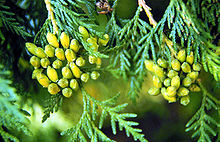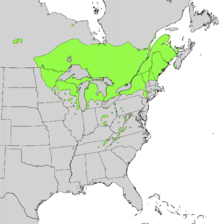Eastern Arborvitae
| Northern white-cedar | |
|---|---|
 |
|
| Leaves and immature cones | |
| Scientific classification | |
| Kingdom: | Plantae |
| Division: | Pinophyta |
| Class: | Pinopsida |
| Order: | Pinales |
| Family: | Cupressaceae |
| Genus: | Thuja |
| Species: | T. occidentalis |
| Binomial name | |
|
Thuja occidentalis L. |
|
 |
|
| Natural range | |
Thuja occidentalis, also known as northern white-cedar or eastern arborvitae, is an evergreen coniferous tree, in the cypress family Cupressaceae, which is native to eastern Canada and much of the north, central and upper Northeastern United States, but widely cultivated as an ornamental plant. The species was first described by Carl Linnaeus in 1753, and the binomial name remains current.
Common names include:
The name arborvitae is particularly used in the horticultural trade in the United States. It is Latin for "tree of life" - due to the supposed medicinal properties of the sap, bark and twigs. Despite its common names, it is not a true cedar in the genus Cedrus, nor is it related to the Australian white cedar, Melia azedarach.
Unlike the closely related western red-cedar (Thuja plicata), northern white-cedar is only a small or medium-sized tree, growing to a height of 15 m (49 ft) tall with a 0.9 metres (2 ft 11 in) trunk diameter, exceptionally to 38 metres (125 ft) tall and 1.8 metres (5 ft 11 in) diameter. The tree is often stunted or prostrate in less favorable locations. The bark is red-brown, furrowed and peels in narrow, longitudinal strips.
A young seedling in the Superior National Forest, Minnesota, showing the feather-like shape of the twigs and leaves
A closeup of the leaves of a tree in Peninsula State Park, Door County, Wisconsin
Botanical illustration from 1913
Northern white-cedar has fan-like branches and scaly leaves. The foliage forms in flat sprays with scale-like leaves 3–5 millimetres (1⁄8–3⁄16 in) long.
...
Wikipedia

